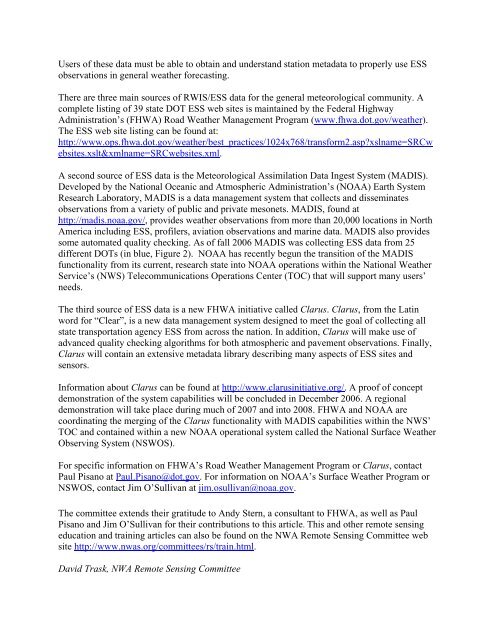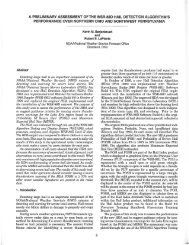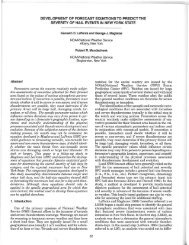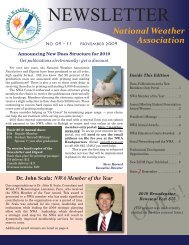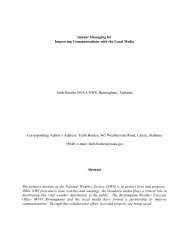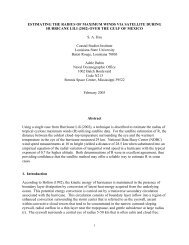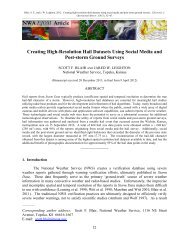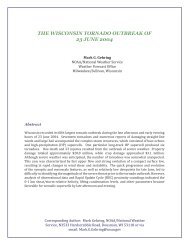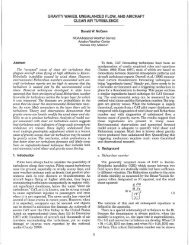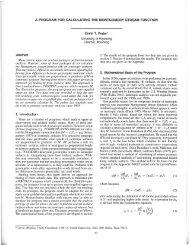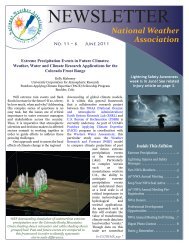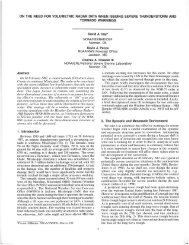Remote Sensing and Winter Weather - National Weather Association
Remote Sensing and Winter Weather - National Weather Association
Remote Sensing and Winter Weather - National Weather Association
Create successful ePaper yourself
Turn your PDF publications into a flip-book with our unique Google optimized e-Paper software.
Users of these data must be able to obtain <strong>and</strong> underst<strong>and</strong> station metadata to properly use ESS<br />
observations in general weather forecasting.<br />
There are three main sources of RWIS/ESS data for the general meteorological community. A<br />
complete listing of 39 state DOT ESS web sites is maintained by the Federal Highway<br />
Administration’s (FHWA) Road <strong>Weather</strong> Management Program (www.fhwa.dot.gov/weather).<br />
The ESS web site listing can be found at:<br />
http://www.ops.fhwa.dot.gov/weather/best_practices/1024x768/transform2.asp?xslname=SRCw<br />
ebsites.xslt&xmlname=SRCwebsites.xml.<br />
A second source of ESS data is the Meteorological Assimilation Data Ingest System (MADIS).<br />
Developed by the <strong>National</strong> Oceanic <strong>and</strong> Atmospheric Administration’s (NOAA) Earth System<br />
Research Laboratory, MADIS is a data management system that collects <strong>and</strong> disseminates<br />
observations from a variety of public <strong>and</strong> private mesonets. MADIS, found at<br />
http://madis.noaa.gov/, provides weather observations from more than 20,000 locations in North<br />
America including ESS, profilers, aviation observations <strong>and</strong> marine data. MADIS also provides<br />
some automated quality checking. As of fall 2006 MADIS was collecting ESS data from 25<br />
different DOTs (in blue, Figure 2). NOAA has recently begun the transition of the MADIS<br />
functionality from its current, research state into NOAA operations within the <strong>National</strong> <strong>Weather</strong><br />
Service’s (NWS) Telecommunications Operations Center (TOC) that will support many users’<br />
needs.<br />
The third source of ESS data is a new FHWA initiative called Clarus. Clarus, from the Latin<br />
word for “Clear”, is a new data management system designed to meet the goal of collecting all<br />
state transportation agency ESS from across the nation. In addition, Clarus will make use of<br />
advanced quality checking algorithms for both atmospheric <strong>and</strong> pavement observations. Finally,<br />
Clarus will contain an extensive metadata library describing many aspects of ESS sites <strong>and</strong><br />
sensors.<br />
Information about Clarus can be found at http://www.clarusinitiative.org/. A proof of concept<br />
demonstration of the system capabilities will be concluded in December 2006. A regional<br />
demonstration will take place during much of 2007 <strong>and</strong> into 2008. FHWA <strong>and</strong> NOAA are<br />
coordinating the merging of the Clarus functionality with MADIS capabilities within the NWS’<br />
TOC <strong>and</strong> contained within a new NOAA operational system called the <strong>National</strong> Surface <strong>Weather</strong><br />
Observing System (NSWOS).<br />
For specific information on FHWA’s Road <strong>Weather</strong> Management Program or Clarus, contact<br />
Paul Pisano at Paul.Pisano@dot.gov. For information on NOAA’s Surface <strong>Weather</strong> Program or<br />
NSWOS, contact Jim O’Sullivan at jim.osullivan@noaa.gov.<br />
The committee extends their gratitude to Andy Stern, a consultant to FHWA, as well as Paul<br />
Pisano <strong>and</strong> Jim O’Sullivan for their contributions to this article. This <strong>and</strong> other remote sensing<br />
education <strong>and</strong> training articles can also be found on the NWA <strong>Remote</strong> <strong>Sensing</strong> Committee web<br />
site http://www.nwas.org/committees/rs/train.html.<br />
David Trask, NWA <strong>Remote</strong> <strong>Sensing</strong> Committee


